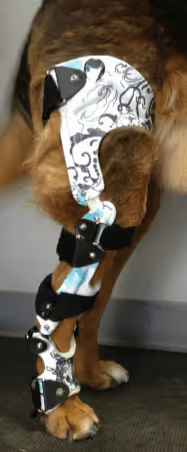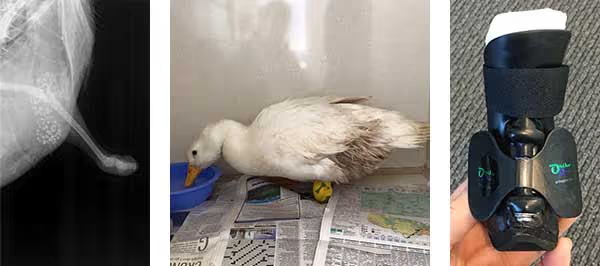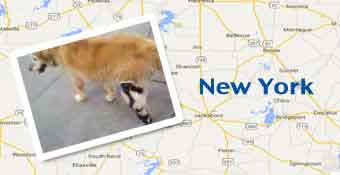Stifle Joint Orthoses

The stifle joint (dog knee) is less complex in that there are fewer bones and ligaments than the tarsus and carpus and only 2 true joints (femoropatellar and femorotibial). However, it is more complex because it is intended to function in more than 1 plane of motion (femorotibial). The stifle (dog knee) is a polycentric joint rather than a monocentric (simple hinge) joint. In addition to sagittal motion, a certain amount of frontal and transverse plane motion provides livelier and more adaptive function. The tibia and femur shear across the articular surfaces as the joint goes through range of motion. Overall, 4 ligaments and 1 tendon (medial and lateral collateral, cranial and caudal cruciate, and the patellar tendon) limit and control motion. Important muscles include the quadriceps group, the hamstring group, the gastrocnemius, and the biceps femoris. Injury to any of these components may be managed surgically or with an orthosis. Rehabilitation is now considered a standard of care in stifle, dog knee, injury.[caption id="attachment_4746" align="alignleft" width="187"]

Fig. 9. An example of stifle orthosis for canine cranial cruciate insufficiency uses
force coupling to limit tibial thrust and internal rotation. This device uses
metatarsal suspension.[/caption]The classic example of transverse and sagittal stifle instability is injury to the cranial cruciate ligament (CCL). The etiology of this injury is beyond the scope of this article; however, knowledge of partial and complete tear is important. Traditionally, partial to complete, all CCL injuries are managed surgically. There are a number of techniques described each with merit, none perfect. Even so, there is a population of dogs for whom surgery is not possible or not appropriate. These include dogs with comorbidities, advanced age, and owners with limited financial means, among others. Until recently, treatment options for these patients were limited to weight management and nonsteroidal anti-inflammatory drugs.Stifle support devices (dog knee braces) have been available for at least a decade. They include off-the-shelf and custom design devices. The intent of all is to support the limb. The degree to which they do is not yet known; however, studies are underway. From a mechanical perspective, a CCL orthosis must restrict tibial translation (cranial shear and internal rotation) or it must impel the muscular structures of the limb to do so. Importantly, the mechanical principle here is not the 3-point correction. This technique would fail during stifle articulation because the stifle undergoes rolling and gliding during normal range of motion. This means that the center of rotation changes, which cannot be accommodated by the 3-point corrective technique. The shearing mechanics of the CCL-deficient stifle are in contradistinction to the relatively simple mechanics of tarsal and carpal instability. Therefore a different technique is needed to stabilize. The proper mechanical principle is called force coupling (Fig 9). It uses the action of the major muscle groups to couple the femur and the crus while allowing a polycentric hinge to provide articulation and limit shear.





